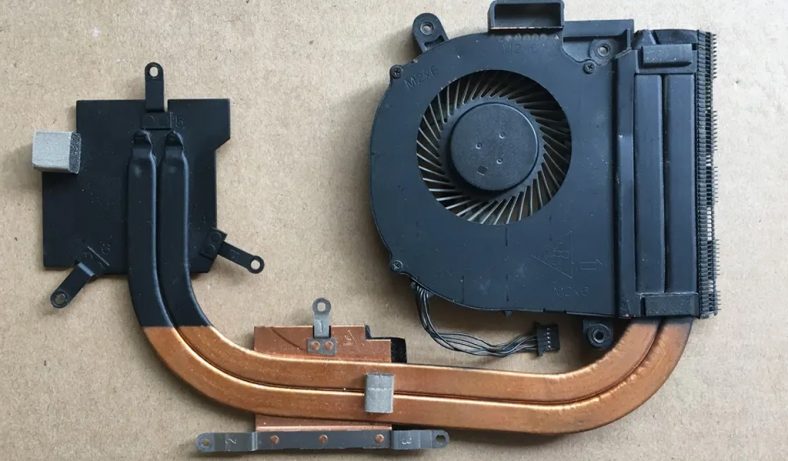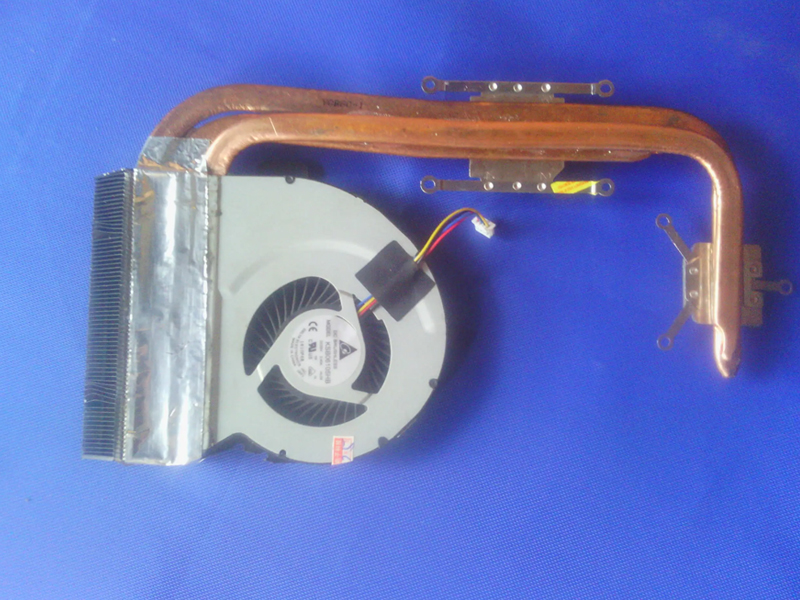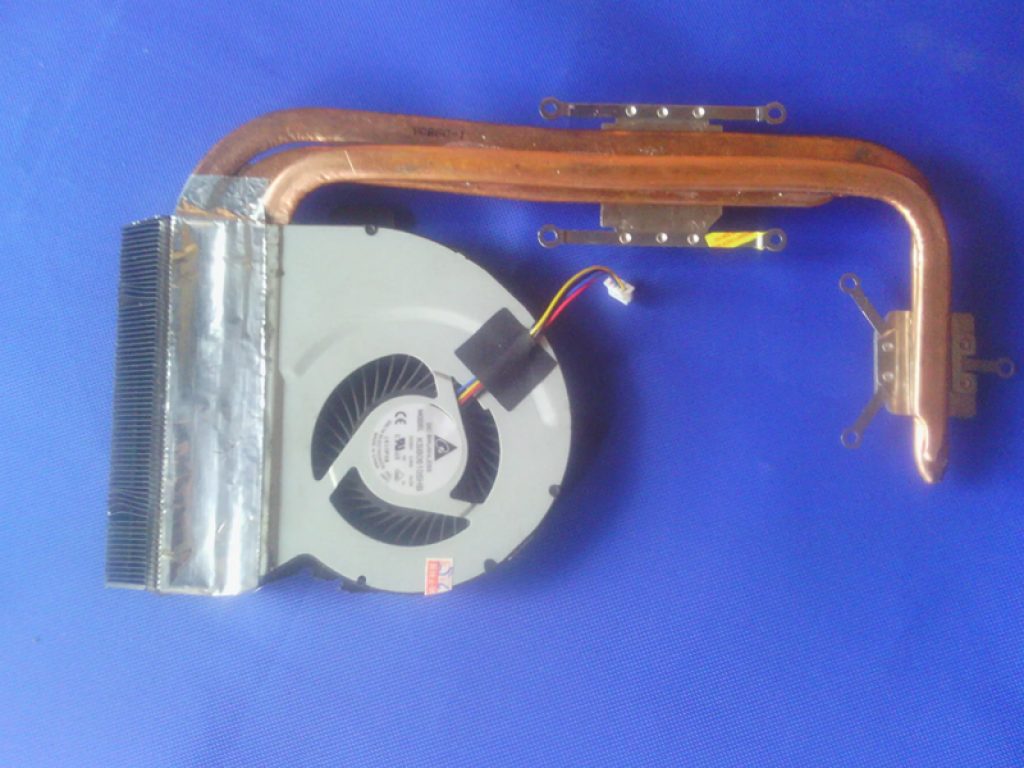
Define Of Laptop Heatsink – What Is Laptop CPU Cooler
The Laptop heat sink is a fan device that blows heat directly against the bottom of the Laptop, forcibly blows the heat of the Laptop, and introduces cold air to increase the air flow at the bottom of the Laptop, so that all heating elements inside the Laptop can be dissipated.

It is a small device that can effectively reduce the temperature of the Laptop computer by effectively maintaining the low temperature working environment inside. However, Laptop heatsink usually only assist Laptop heat dissipation, and most of the heatsink mainly reduce the external temperature of the Laptop by strengthening the air flow speed of the bottom plastic shell, while the internal heat of the Laptop mainly relies on the CPU fan to force convection to bring it out.
The Laptop radiator relay takes the heat away to complete the cooling, so the external cooling effect alone cannot reach our ideal state.
With the changes in the market and the upgrading of products, there are now dedicated heatsink with fans that can move freely, as well as heat-extracting heatsink that directly draw hot air from the air outlet of the Laptop.
The Features Of Laptop Heatsink
- Each corner of the heatsink panel has fine chamfering treatment, which will not bring scratches to the Laptop;
- Reasonable slope setting, more comfortable when using the Laptop;
- When using a Laptop for a long time, it is logical to cool down. Due to the continuous increase in the frequency of mainstream Laptops, the temperature of long-term use is also getting higher and higher. In order to better protect his love “Laptop” does need to cool down. The cooling pad can help our Laptops stay away from the pain of high temperature and ensure the normal operation of the Laptops;
- Blow heat directly to the bottom of the laptop, force the heat out of the laptop, and introduce cold air to increase the air flow at the bottom of the laptop, so that all heating elements inside the laptop are dissipated, effectively maintaining the internal low temperature working environment;
- The USB power supply design is directly connected to the USB interface of the Laptop without adding sockets and other equipment;
- The wind speed of the heatsink of a single fan is not very large, but it definitely does not mean that the cooling effect is not good. Because it is a single super fan, the speed of the fan is a constant value set by the manufacturer after testing. Such a speed can achieve the life of the fan and the cooling effect. The best balance of the heatsink, the effect of this heatsink is good or bad, it should be the result of a customer’s long-term use.
The Precautions Of Laptop Heatsink

The Heatsink Material Determines Success Or Failure
In the past two years, the types of Laptop heatsinks have become more and more, but there has also been a chaotic situation. Therefore, when purchasing, the most important thing to pay attention to is the material of the Laptop heatsink. At present, non-brand products usually use plastic materials, which not only have poor thermal conductivity, but also have unreasonable shape design. Relatively speaking, brand-name products use aluminum alloys with high thermal conductivity, and their heat dissipation effect is satisfactory. In addition, when purchasing, you should also pay attention to whether the edge of the heatsink is smooth, and whether the surface of the heatsink adopts a non-slip design. Otherwise, if the handle is scratched, or the Laptop “slips” off the heatsink, it will not be worth the loss.
The Heatsink Fan Is Really Annoying
Laptop coolers usually adopt a dual-fan design or a triple-fan design, and the cooling effect is mainly determined by the airflow generated by the fans, not the number of fans. Therefore, when purchasing a Laptop heatsink, do not blindly believe in the three-fan design, and sometimes the dual-fan design is better. The ideal solution is to experience it yourself with your own laptop, so that you can buy the most suitable product. In addition, it should be noted that some dual-fan designs have a stronger heat dissipation effect, which is achieved by increasing the fan speed. Then came the obvious noise. Therefore, users of books must pay special attention to the noise problem of the heatsink when purchasing. Only when there is no obvious noise in a quiet environment, it is suitable for Laptop users to buy!
The External Power Supply Of The Heatsink Is More Flexible
Most laptop coolers are powered by USB, which is very convenient. However, if you use the USB power supply when using the battery, it may cause insufficient power supply of the Laptop, which will shorten the battery life of the Laptop, or occupy the precious USB interface and cannot connect to other devices. So in theory, it is best to buy a Laptop cooler that also has an external power supply. In this way, when there is an external power supply or when multiple USB devices do not need to be connected, the USB power supply is used, and when the Laptop is under heavy workload or needs to be connected with multiple USB devices, the external power supply is used for power supply. Not only the use is more flexible, but also will not affect the use of other USB devices.
The Adjustable Speed Heatsink Is More Valuable
Fan noise is unavoidable, but it can be reduced by lowering the speed. On days when the weather is not too hot, a Laptop heatsink with a speed regulation function is more worthy of favor. At present, the fans of Laptop heatsinks usually have three-level speed regulation of high, medium and low gears. Just like an electric fan, it adjusts according to the temperature. When purchasing a Laptop heatsink, try to buy products with speed regulation functions. In addition, Laptop coolers with software control and automatic monitoring can also be considered more.
The Careful Selection Of Exhaust Heatsinks
In addition to pedestal coolers, PC card coolers have also appeared in the market. This kind of heatsink can be directly inserted into the PC card slot of the Laptop, and uses the fan to rotate to draw out the air, so as to achieve the purpose of cooling the Laptop quickly. However, due to differences in internal design, this cooler is not suitable for all Laptops. If it is used forcibly, it will disturb the internal air convection and cause constant high fever inside the Laptop, so this kind of heatsink is only a no-name product. In addition, there is an exhaust heatsink with a similar shape to it. This heatsink also draws air outward, but it is installed in the exhaust port of the Laptop. Therefore, the direction of exhaust air can be consistent with the direction of air flow inside the Laptop. , so it can be considered.
“Increasing” Books Can Also Improve Heat Dissipation
The reason why the Laptop needs a heatsink is mainly due to the poor air circulation at the bottom. Therefore, there is also a Laptop foot pad on the market, which can also be regarded as a special heatsink. After using the foot pad, the Laptop is “increased”, and the distance from the desktop is much larger. The air at the bottom is easier to circulate, and the heat dissipation problem has been solved to a certain extent.
Ergonomics Of Laptop Cooler
Using a notebook for business office and games for a long time will lead to operative lumbar and spine injuries, and the notebook radiator is ergonomically designed, which can better adapt to and meet people’s choices from various angles, making people more comfortable at work. , safety and health. Thereby improving work efficiency.

The Heater principle Of Laptop Heatsink
Using a notebook for business office and games for a long time will lead to operative lumbar and spine injuries, and the notebook radiator is ergonomically designed, which can better adapt to and meet people’s choices from various angles, making people more comfortable at work. , safety and health. Thereby improving work efficiency.
Material Of Heat Dissipation Base
There are two types of materials used in the main products on the market today: metal or plastic. Metal has good thermal conductivity, but the bottom of any notebook has a non-slip rubber pad, which cannot be closely attached to the metal heat dissipation base, so the thermal conductivity of metal cannot be fully exerted. Of course, the metal base can better absorb and diffuse the heat emitted from the notebook. In addition, the metal is generally heavier, and due to the high process requirements during manufacturing, once the workmanship is not fine enough, it can easily become a sharp weapon to hurt people. Plastic materials are generally lighter and have higher hardness, and many engineering plastics are even stronger than metals. For cost and portability considerations, notebooks with lighter weight and less heat can choose a better-designed plastic cooling base. However, if it is a heavy notebook with high heat generation, it is recommended to buy a heat dissipation base made of metal material with good workmanship.
The Principle Of Heat Dissipation Base
Heat dissipation is actually a process of heat transfer—conduction, convection, radiation, etc. Usually in desktop computers, air-cooling technology is mainly used, which includes CPU, graphics card, power supply, and cooling fans of the chassis. In notebook computers, air-cooling is still the main cooling method, and the vast majority of cooling methods are: fan + heat pipe + Cooling plate combination. Many notebook computers use aluminum-magnesium alloy shells, which also play a certain role in heat dissipation. As we all know, there are generally cooling vents at the bottom of the notebook computer, either inhaled or blown out, which are very important for the cooling of the notebook computer. Laptops are also designed with heat dissipation in mind. They often use pads to raise the fuselage, but when the temperature is too high, it seems reluctant.
There are two main cooling principles for notebook cooling bases:
- The heat dissipation function is realized purely through the principle of heat conduction in physics. Placing a plastic or metal cooling base on the bottom of the notebook and elevating the notebook to promote air circulation and heat radiation can achieve cooling effects.
- Install several cooling fans on the heat dissipation base to improve the heat dissipation performance. This air-cooled heat dissipation method includes two types of suction and blowing. The difference between the two air supply forms is the difference in the air flow form. The turbulent flow is generated when blowing, which belongs to active heat dissipation. The wind pressure is large but it is prone to resistance loss, such as electric fans that people use in summer; Flow, which belongs to passive cooling, the wind pressure is small but the airflow is stable, such as the case fan.
Theoretically, in an open environment, the heat exchange efficiency of turbulent flow is greater than that of laminar flow, but the bottom of the notebook and the heat dissipation base actually form a closed space, so the general air suction and heat dissipation method is more in line with the air flow design specifications. Most of the cooling bases on the market have built-in suction fans, which are mainly introduced below.
The Structure Of The Heat Dissipation Base
The structure of the fan-type heat dissipation base is actually not complicated. Generally, it is composed of a metal or plastic shell and built-in 2–4 fans. The power supply scheme of the fan includes two kinds of power supply through the notebook usb interface and external power supply. Some The product also has the function of expanding multiple usb ports. Most of the fans of the cooling base of notebook computers are designed with suction, because this can minimize the impact of air disturbances and improve heat dissipation efficiency.
The number and layout of the cooling base fans are also very important. The rear of the notebook is often the battery, and some major heat-generating components such as the CPU and the hard disk are located relatively in the middle, especially the hard disk, which are mostly designed under the hand rest, and these parts have a lot of heat dissipation. The base is often not designed with a fan. Therefore, before purchasing a cooling base, it is best to find out the positions of several main components of the base of your notebook. The easiest way is to let the notebook touch the bottom and desktop directly after turning on the notebook for an hour, and determine the hottest positions. it is good. Then, try to choose a base with a fan layout that is closer to the heat-generating position.
Try to buy a cooling base with an independent power supply switch, and check whether there is a non-slip or fixed structure that can effectively avoid accidents. The size and color are based on personal preferences.
The Performance Of The Heat Dissipation Base
Performance judgment method: In the same environment, without using the heat dissipation base, record the main temperature parameters of the system after five minutes and one hour of power on respectively; then use the heat dissipation base, and also record the main temperature parameters of the system after five minutes and one hour of power on; Comparing these four temperature values, we can roughly determine the heat dissipation performance of the heat dissipation base.
Also need special attention is the noise and vibration of the cooling base, the number and quality of the fans are the determining factors. Although many fans increase the heat dissipation effect, the corresponding power consumption and noise and vibration also increase, so generally 2 to 3 are appropriate. Therefore, when purchasing a base for testing, you need to pay attention to determine whether the noise is acceptable and whether there will be vibrations that affect the computer hard drive.
The Precautions For The Use Of Heat Dissipation Base
The notebook cooling base is very simple to use. First, lay the notebook cooling base flat, then connect the power supply, turn on the front power supply switch with the fan hole of the cooling base facing upwards, and finally place the notebook flat on the cooling base. No matter what the environment is, pay attention to leave the air outlets of all cooling fans to ensure that the air can carry heat and quickly diffuse out.
The Principle Of Pumping Heat Sink
The heat-extracting radiator draws out the internal heat of the notebook through the air outlet of the notebook computer, and at the same time introduces cold air to cool the inside of the notebook computer.




